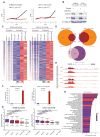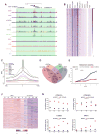Therapeutic targeting of polycomb and BET bromodomain proteins in diffuse intrinsic pontine gliomas
- PMID: 28263307
- PMCID: PMC5667640
- DOI: 10.1038/nm.4296
Therapeutic targeting of polycomb and BET bromodomain proteins in diffuse intrinsic pontine gliomas
Abstract
Diffuse intrinsic pontine glioma (DIPG) is a highly aggressive pediatric brainstem tumor characterized by rapid and uniform patient demise. A heterozygous point mutation of histone H3 occurs in more than 80% of these tumors and results in a lysine-to-methionine substitution (H3K27M). Expression of this histone mutant is accompanied by a reduction in the levels of polycomb repressive complex 2 (PRC2)-mediated H3K27 trimethylation (H3K27me3), and this is hypothesized to be a driving event of DIPG oncogenesis. Despite a major loss of H3K27me3, PRC2 activity is still detected in DIPG cells positive for H3K27M. To investigate the functional roles of H3K27M and PRC2 in DIPG pathogenesis, we profiled the epigenome of H3K27M-mutant DIPG cells and found that H3K27M associates with increased H3K27 acetylation (H3K27ac). In accordance with previous biochemical data, the majority of the heterotypic H3K27M-K27ac nucleosomes colocalize with bromodomain proteins at the loci of actively transcribed genes, whereas PRC2 is excluded from these regions; this suggests that H3K27M does not sequester PRC2 on chromatin. Residual PRC2 activity is required to maintain DIPG proliferative potential, by repressing neuronal differentiation and function. Finally, to examine the therapeutic potential of blocking the recruitment of bromodomain proteins by heterotypic H3K27M-K27ac nucleosomes in DIPG cells, we performed treatments in vivo with BET bromodomain inhibitors and demonstrate that they efficiently inhibit tumor progression, thus identifying this class of compounds as potential therapeutics in DIPG.
Conflict of interest statement
The authors declare no competing financial interests.
Figures




Comment in
-
Neuro-oncology: New therapeutic targets for diffuse intrinsic pontine glioma.Nat Rev Neurol. 2017 Apr;13(4):196. doi: 10.1038/nrneurol.2017.39. Epub 2017 Mar 17. Nat Rev Neurol. 2017. PMID: 28303929 No abstract available.
-
Untangling the role of mutant histone H3 in diffuse intrinsic pontine glioma.Nat Med. 2017 Apr 7;23(4):413-414. doi: 10.1038/nm.4320. Nat Med. 2017. PMID: 28388610 No abstract available.
References
MeSH terms
Substances
Grants and funding
LinkOut - more resources
Full Text Sources
Other Literature Sources
Molecular Biology Databases
Research Materials

